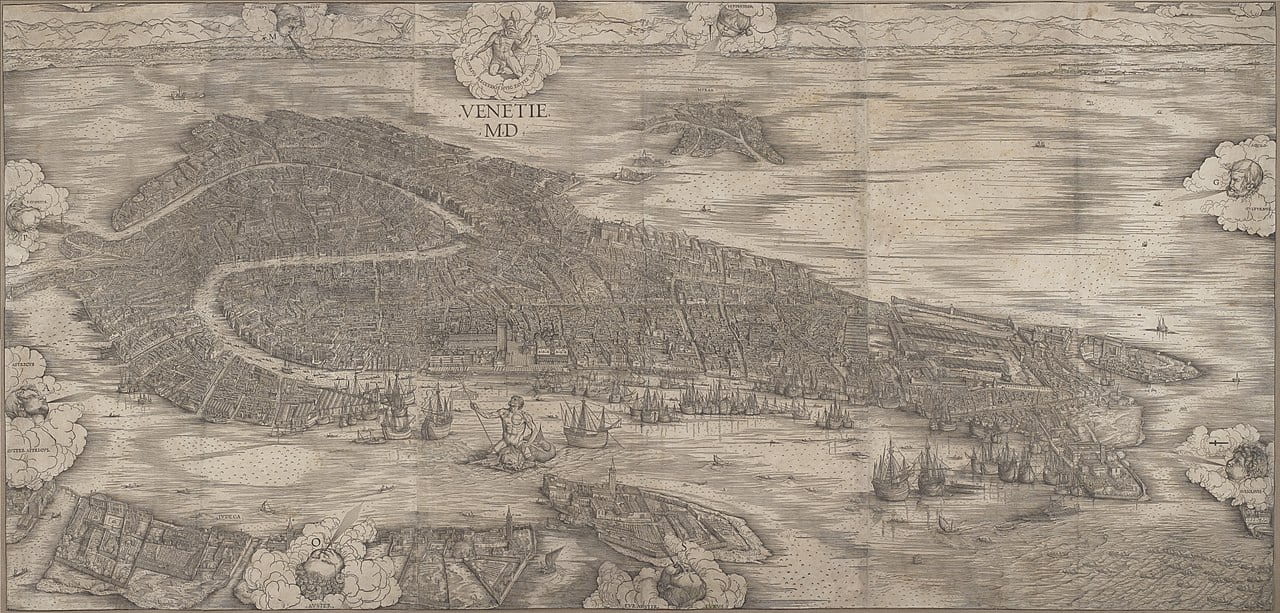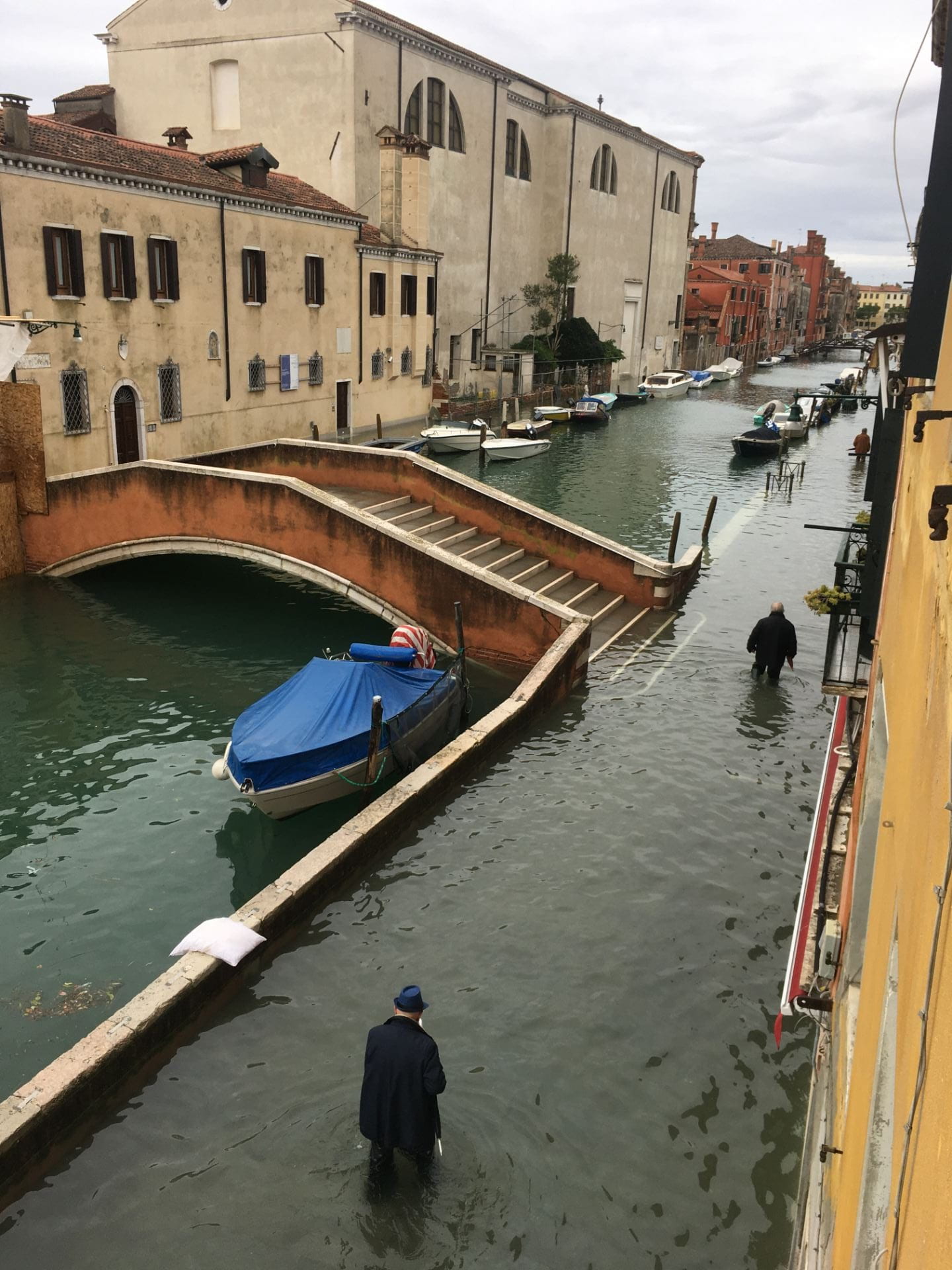
Exploring Venice’s Past and Present
From September to December 2019, History postgraduate researcher Jennifer McFarland was based in Venice as one of two Australasian Centre of Italian Studies (ACIS)-Save Venice research fellows at Save Venice Inc.’s Rosand Library and Study Centre. The fellowship supported archival research for her Master’s thesis, which focuses on the visibility and social role of pizzochere, or lay religious women, in sixteenth-century Venice. In this blog post, Jen outlines her research project and looks back on her stay in Venice, including the acqua alta of November 2019, which brought a vivid reminder of the fragility of Venice’s precious cityscape.
Writing in 1494, the Milanese canon Pietro Casola described Venice as ‘not one city alone, but several cities placed together’. Venice’s position as ‘the city founded on the sea’ is unique. But beyond that, the sense of the diversity among the complex of tiny, interconnected islands is one of the most commented-upon aspects of the city in Renaissance accounts. The sharpness of the contrasts between the different neighbourhoods remains one of the most striking things about Venice today; the city’s physical appearance and structures can change very rapidly as you cross its little bridges. These spatial and structural changes can illuminate the city’s history. They can signal what sort of place an area might have been, and what kind of people it was designed for and used by; attention to them can help us to understand the city’s social structures and power dynamics.
My Master’s thesis is primarily interested in the visible presence and social role of one particular category of Venetians: pizzochere, or lay religious women. It focuses on the sixteenth century, a period marked by strong governmental and Church emphasis on confining religious women, as well as other social categories, to particular spaces, often hidden from view and removed from interactions with the broader population. As lay religious, pizzochere took simple religious vows, pursuing an active vocation either in their own homes, or in unenclosed collective houses.

Venice’s communities of pizzochere have not previously been the subject of a focused academic study. But, at the end of the sixteenth century, they seem to have had a strong presence in the Venetian cityscape. Such a presence, in fact, that they were included as a social category in the Venetian section of Cesare Vecellio’s 1590 costume book. And a handful of spaces in the city still bear the designation ‘delle pizzochere’; for example, a corte in what is today the parish of Santo Stefano.

As part of my Master’s project, I set out to understand who became a pizzochera in sixteenth-century Venice, and the various circumstances that might have motivated that decision. To analyse socioeconomic background, as well as the overall presence of these women in the city, I have been using both privately and state-generated material to map the spaces that pizzochere inhabited and likely moved through, as well as the people among whom they lived as neighbours.
Preliminary work suggests that most of these spaces were situated in less well-off areas of the city, and both neighbourhood and neighbours imply the artisan and working background of a significant number of pizzochere. That status is also implied by the small amount of information available about the trades practised by their fathers, husbands and/or other male relatives and associates or, much more infrequently, by pizzochere themselves.
Their living arrangements varied. Many lived in large collective dwellings that resembled convents, or in a room or rooms in the house of a family member or landlord. A small few resided in hospitals and hospices, and several were the apparent head of their own small household. This variety suggests that the lay religious habit might have provided a certain freedom in the city, something which my project also seeks to explore.
One of the most valuable aspects of the fellowship was simply being in the city for an extended period of time. Living in Venice enabled me to gain a better understanding of how the city ‘works’ spatially, and a finer sense of how pizzochere may have fitted into their neighbourhoods. Being in the city reinforces quite how visible any inhabitant is in a space that is and was so densely built up, and where the main means of transport for most people has always been walking. That sense is unavoidably heightened when you realise that the women you are researching lived in a campo (square) or calle (street) that you walk through almost every day, or a few doors down from a friend’s house. It makes obvious also the unique logistics of Venice — for example, the challenges the city presents for something like a funeral (which come up in my research far more than I had anticipated). Or, the way in which the need for bridges funnels people down regular paths, forcing interaction, and simultaneously can cloister whole sections of a city, limiting contact or offering a means of deliberate control.

High Water
If the need for bridges can cloister, so can the tide. In the 1520s the Venetian patrician Marin Sanudo could record the way in which ‘grandissima aqua’ (sic.) (‘very high water’) accompanied by extreme winds and rain confined Venetians to their houses, and prevented the city’s government from meeting normally. The exceptional tide that hit the city on 12 November 2019 was accompanied by high winds and heavy rain. It did much more than prevent movement, resulting in billions of euros worth of damage, and a state of emergency being declared in the municipality.
At 1.87 metres, the 12 November tide came just seven centimetres short of the highest recorded, 1.94 metres on 4 November 1966. The memory of that flood is quite literally inscribed on the city, either through visible remnants of now-repaired damage, or more deliberately: in the Sala delle Colonne (Hall of Columns) at the Scuola Grande di San Giovanni Evangelista the ’66 water level is marked, by hand, on one of the columns. Venetians have begun to do the same for the 12 November water level.

It’s true that a degree of acqua alta is a semi-regular part of life in the last months of the year. Very quickly, you learn to walk differently, and that even just ankle-deep, it will take you at least twice as long as usual to get anywhere. But exceptionally high tides are becoming more regular, ever higher, and more destructive. Climate change and rising sea levels, dredging to enable the cruise industry, as well as subsidence, have all contributed to this.
As a result, there is frustration and anger in the city. #graziemose (a sarcastic reference to the controversial and yet-to-be-completed project to build a flood protection barrier, titled ‘Mose’) was graffitied on more than one edifice, as were other comments about government inaction over climate change, and the industries that are overwhelming the city.
Many of the conservation and restoration organisations working in Venice today, Save Venice Inc. included, were initially created in response to the 1966 flood. Save Venice’s immediate response to the 2019 acqua alta has involved cleaning and reinforcing work in ten churches, as well as several other heritage buildings across the city. But long-term damage will need ongoing management and treatment, and is still largely invisible. The ongoing impact of these floods is a reminder of the fragility of the balance that makes Venice ‘work’.
The ACIS–Save Venice Fellowship
The fellowship was offered through the Australasian Centre of Italian Studies (ACIS), which supports and promotes Italian Studies in Australia, together with Save Venice Inc., an American non-profit that supports the conservation and restoration of artistic heritage in the city.
The opportunity to have extended access to archival material was invaluable. But the fellowship also enabled me to view images, from monumental cycles to prints, in a level of detail not possible from home. Save Venice’s own archive, which documents their conservation and restoration projects in the city, was a really important aspect of this. I appreciated how generous Melissa Conn, director of the Venice Office, was in discussing some of the restorations with me. Being able to wander through collections brought new images to my attention, and raised different questions about where, how and why Venetians engaged with the figure of the pizzochera, as much as with the women themselves.
Being based in the city also offered the opportunity to attend seminars and lectures hosted by other institutions, as well as roundtables and conferences hosted by Save Venice in the Rosand Library and Study Centre. Each month, specialists working on one of Save Venice’s current projects present progress and findings to a public audience. In addition, in October 2019, Save Venice hosted a biannual meeting of the Associazione di Commitati Privati Internazionali per la Salvaguardia di Venezia (Association of Private International Committees for the Safeguarding of Venice). The Associazione draws together twenty-one local and foreign private committees that facilitate restoration and conservation work in the lagoon. Attending these events gave me a much clearer picture of current conservation projects, and a deeper understanding of the particular problems that impact the city. I was impressed to see how strong the dedication is to both public education and to supporting graduate students and researchers in particular. All of these activities provided exciting opportunities to hear from and meet Venetianists working in different disciplines, and to be in contact with other grad students working on similar material – and sharing their tips on how to navigate the city’s research institutions!
Applications for the 2020 round of ACIS-Save Venice fellowships close on 9 March 2020. Details can be found via ACIS.
Undergraduate offerings for students at the University of Melbourne interested in learning about the history of Venice include: HIST30051 Venice and Cultures of Consumption; and HIST30006 The Renaissance in Italy.